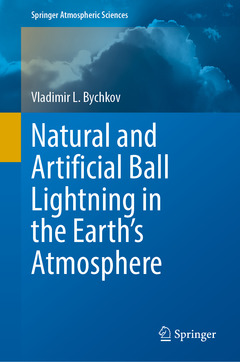Description
Natural and Artificial Ball Lightning in the Earth's Atmosphere, 1st ed. 2022
Springer Atmospheric Sciences Series
Author: Bychkov Vladimir L.
Language: English
Subjects for Natural and Artificial Ball Lightning in the Earth's...:
Publication date: 08-2023
438 p. · 15.5x23.5 cm · Paperback
Publication date: 08-2022
438 p. · 15.5x23.5 cm · Hardback
Description
/li>Contents
/li>Biography
/li>Comment
/li>
Chapter 1. Ball lightning (BL) and its researchers
Russian researchers
Western scientists in the field of BL physics
Chapter 2. Observational data on events associated with BL
BL energy
The appearance of BL
External features of BL
Size, color and shape of BL
Complex structures.
BL in the form of a thread or harness
Electrical manifestations of BL
The interaction of BL with various objects
The interaction of BL with glass
Injuries and death of observers and animals when exposed to BL
Moving objects when exposed to BL
Meeting of BL with airplanes
Meeting of BL with airplanes (observation)
Meeting of BL with airplanes (processing of observations)
BL and the sea
BL and geotectonic events
Luminous formations generated by geotectonic activity
BL in Japan
Artifacts and various traces of BL
Geophysical phenomena and BL
Abnormal properties of BL
Holes in the Earth and observation of BL
BL, crop circles and on the surface of the Earth
Globular nodules
Glowing objects of Hessdalen
Local heating of objects
Gel-like meteors and similar phenomena
Addendum to the section
Photo and video with BL
BL near the Black Sea
BL in Dolgoprudny
BL in Mitino
About phosphenes formed as a result of energetic radiation of linear lightning flashesChapter 3. Analysis of observations of BL
Collection of observational data
Analysis of observations by the simplest methods
Modern methods of statistical analysis of BL
Statistical studies of the color of BL
Analysis of variance. Data processing procedure
ANOVA results for the color factor of BL
Correlation analysis of distributions of BL by color
Factors affecting the observed parameters of BL
ANOVA for the factor of the location of observation of BL outdoors and indoors
The significance of the factors that determine the way of death of BL. Analysis of variance.The significance of the ball lightning diameter for its lifetime. Analysis of variance results.
Dependence of the lifetime of BL on its diameter.
Influence of thunderstorm atmospheric conditions on the properties of BL.
Chapter 4. Experimental modeling of BL and long-lived luminous formations
Introduction
Early experiments of the 19th and 20th centuries for the purposeful creation of BL.
Experiments on the production of BL and long lived formations (LLF) in electric discharge conditions
Plasmodynamic formations and (LLF)
Erosive discharge
Pulsed electrical discharge in a channel with evaporating walls
Experiments with erosive discharge with a wax capillary
Erosion Discharge Experiments with a PMMA Capillary
Experiments with polymeric materials
Effect of plasmatron plasma on polymer materials
Characteristics of the plasma jets of the capillary plasmatron
Getting glowing balls and LLF
Obtaining LLF with a polymer structure
Floating Ball Temperature
Possible nature of LLF created using a capillary plasmatron
§4.6.5 Experiments on the interaction of an erosion discharge jet with a metal sample
Slit Erosion Discharge Experiments
Experiments on the interaction of an erosion discharge jet with an alloy
Development of work on erosional discharges with tin alloy electrodes.
Conclusions for the section
Electric discharge in water
Microscopic ball lightningExperiments on modeling the features of BL
Modeling the interaction of BL with glasses
Results of the natural interaction of BL with glasses
Experimental modeling of the interaction of BL with glasses
Discussion of simulation results
Event in Shchelkovo
Mirror event
About the passage of BL through glass
Glass research results
The discussion of the results
Section comment
Chapter 5. About theoretical models of BLNew models of BL
Material Models
Dipole force
The electric field of a highly charged BL
Lifetime of a charged ball relative to neutralization by air ions.
Influence of the plasma sheet on the motion of the ball
BL of A.I. Nikitina
Chemical-thermal models of BL
BL as a condensed structure
BL energy
Details of the chemical-thermal model
"Chinese BL"
About the ability of BL to levitate steadily near the surface of the Earth.
Etheric model of BL
The simplest ethereal model of the BL. Interpretation of anomalous properties
Interpretation of Tesla's CMM experiments. Resonant mechanism of anomalous phenomena in electrical devices
Afterword
Presents new data on ball lightning observations
Includes descriptions of main experiments on ball lightning modelling
Gives a short review of new theoretical ideas
These books may interest you

The Nature of Ball Lightning 52.74 €



